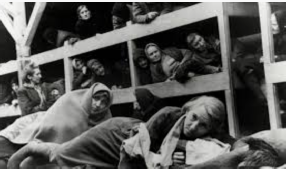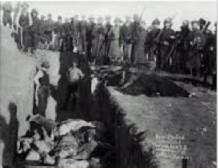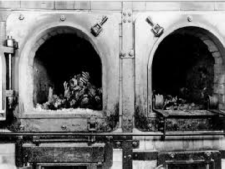|
CLICK BUTTON TO GO |
|
|
|
|
|
|
|
|
|
|
|
|
|
Videos |
|
|
|
|
|
|
|
|
|
|
|
|
|
PART 1 T O P I C |
|
|
|
|
|
|
|
|
|
|
|
|
|
|
|
|
|
|
JewishWikipedia.info
Holocaust Reparations - Frequently Asked Questions
for some common questions and answers
Restitution legislation varies by country. For details go to
RESTITUTION BY COUNTRY
World Jewish Restitution Organisation
MISSING OBJECT DATABASES
Missing Object Databases
ALL SURVIVORS NEED TO CONTACT THEIR LOCAL ORGANISATION
FOR INFORMATION AND MEET OTHER SURVIVORS
Nazi plunder refers to art theft and other items stolen as a result of the organized looting of European countries during the time of the Third Reich by agents acting on behalf of the ruling Nazi Party of Germany. Plundering occurred from 1933 until the end of World War II, particularly by military units known as the Kunstschutz, although most plunder was acquired during the war. In addition to gold, silver and currency, cultural items of great significance were stolen, including paintings, ceramics, books, and religious treasures. Although most of these items were recovered by agents of the Monuments, Fine Arts, and Archives program (MFAA, also known as the Monuments Men), on behalf of the Allies immediately following the war, many are still missing.There is an international effort underway to identify Nazi plunder that still remains unaccounted for, with the aim of ultimately returning the items to the rightful owners, their families or their respective countries.
Adolf Hitler was an unsuccessful artist who was denied admission to the Vienna Academy of Fine Arts. Nonetheless, he thought of himself as a connoisseur of the arts, and in Mein Kampf he ferociously attacked modern art as degenerate, including Cubism, Futurism, and Dadaism, all of which he considered the product of a decadent twentieth century society. In 1933 when Hitler became Chancellor of Germany, he enforced his aesthetic ideal on the nation. The types of art that were favored amongst the Nazi party were classical portraits and landscapes by Old Masters, particularly those of Germanic origin. Modern art that did not match this was dubbed degenerate art by the Third Reich, and all that was found in Germany's state museums was to be sold or destroyed. With the sums raised, the Führer's objective was to establish the European Art Museum in Linz. Other Nazi dignitaries, like Reichsmarschall Hermann Göring and Foreign Affairs minister von Ribbentrop, were also intent on taking advantage of German military conquests to increase their private art collections.
While the Nazis were in power, they plundered cultural property from every territory they occupied. This was conducted in a systematic manner with organizations specifically created to determine which public and private collections were most valuable to the Nazi Regime. 1940, Hermann Göring, who in fact controlled the ERR, issued an order that effectively changed the mission of the ERR, mandating it to seize "Jewish" art collections and other objects.
Art collections from prominent Jewish families were the targets of confiscations because of their significant value. Hitler later ordered that all confiscated works of art were to be made directly available to him.
After Hitler became Chancellor, he made plans to transform his home city of Linz, Austria into the Third Reich's capital city for the arts. Hitler hired architects to work from his own designs to build several galleries and museums, which would collectively be known as the Führermuseum. Hitler wanted to fill his museum with the greatest art treasures in the world, and believed that most of the world's finest art belonged to Germany after having been looted during the Napoleonic and First World wars.
The Hermann Göring collection, a personal collection of Reichsmarschall Hermann Göring, was another large collection including confiscated property, consisted of approximately 50 percent of works of art confiscated from the enemies of the Reich.
The Third Reich amassed hundreds of thousands of objects from occupied nations and stored them in several key locations, such as Musée Jeu de Paume in Paris and the Nazi headquarters in Munich.
The Allies created special commissions, such as the Monuments, Fine Arts and Archives (MFAA) organization to help protect famous European monuments from destruction, and after the war, to travel to formerly Nazi-occupied territories to find Nazi art repositories. In 1944 and 1945 one of the greatest challenges for the "Monuments Men" was to keep Allied forces from plundering and "taking artworks and sending them home to friends and family"; When "off-limits" warning signs failed to protect the artworks the "Monuments Men" started to mark the storage places with white tape, which was used by Allied troops as a warning sign for unexploded mines. They recovered thousands of objects, many of which were pillaged by the Nazis.
To investigate and estimate Nazi plunder in the USSR during 1941 through 1945, the Soviet State Extraordinary Commission for Ascertaining and Investigating the Crimes Committed by the German-Fascist Invaders and Their Accomplices was formed on 2 November 1942. During the Great Patriotic War and afterwards, until 1991, the Commission collected materials on Nazi crimes in the USSR, including incidents of plunder. Immediately following the war, the Commission outlined damage in detail to sixty-four of the most valuable Soviet museums, out of 427 damaged ones. In the Russian SFSR, 173 museums were found to have been plundered by the Nazis, with looted items numbering in the hundreds of thousands.
After the dissolution of the USSR, the Government of the Russian Federation formed the State Commission for the Restitution of Cultural Valuables to replace the Soviet Commission.
After the occupation of Poland by German forces in September 1939, the Nazi regime attempted to exterminate its upper classes as well as its culture. Thousands of art objects were looted, as the Nazis systematically carried out a plan of looting prepared even before the start of hostilities. 25 museums and many other facilities were destroyed. The total cost of German Nazi theft and destruction of Polish art is estimated at 20 billion dollars, or an estimated 43% of Polish cultural heritage; over 516,000 individual art pieces were looted, including 2,800 paintings by European painters; 11,000 paintings by Polish painters; 1,400 sculptures; 75,000 manuscripts; 25,000 maps; 90,000 books, including over 20,000 printed before 1800; and hundreds of thousands of other items of artistic and historical value. Germany still has much Polish material looted during World War II. For decades there have been mostly futile negotiations between Poland and Germany concerning the return of the looted property.
(Each country occupied by the Nazis and their Allies can give a similar analysis)
The Hermann Göring collection, a personal collection of Reichsmarschall Hermann Göring, was another large collection including confiscated property, consisted of approximately 50 percent of works of art confiscated from the enemies of the Reich. Assembled in large measure by art dealer Bruno Lohse, Göring's adviser and ERR representative in Paris, in 1945 the collection included over 2,000 individual pieces including more than 300 paintings. (See also Hermann Goering's 'full catalogue' of looted Nazi art published for first time, The Telegraph, Henry Samuel, Paris, 30 Sep 2015)
The Allies found these artworks in over 1,050 repositories in Germany and Austria at the end of World War II. In summer 1945, Capt. Walter Farmer became the collecting point's first director. The first shipment of artworks arriving at Wiesbaden Collection Point included cases of antiquities, Egyptian art, Islamic artefacts, and paintings from the Kaiser Friedrich Museum. The collecting point also received materials from the Reichsbank and Nazi-looted, Polish, liturgical collections. At its height, Wiesbaden stored, identified, and restituted approximately 700,000 individual objects including paintings and sculptures, mainly to keep them away from the Soviet Army and wartime reparations.
The Allies collected the artworks and stored them in collecting points, in particular the Central Collection Point in Munich until they could be returned. The identifiable works of art, that had been acquired by the Germans during the Nazi rule, were returned to the countries from which they were taken. It was up to the governments of each nation if and under which circumstances they would return the objects to the original owners.
When the Munich collection point was closed, the owners of many of the objects had not been found. Nations were also unable to find all of the owners or to verify that they were dead. There are many organizations put in place to help return the stolen items taken from the Jewish people. For example: Project Heart, the World Jewish Restitution Organization, and The Claims Conference. Depending on the circumstances these organizations may receive the art works in lieu of the heirs.
When the Munich collection point was closed, the owners of many of the objects had not been found. Nations were also unable to find all of the owners or to verify that they were dead. There are many organizations put in place to help return the stolen items taken from the Jewish people. For example: Project Heart (Project Heart : Holocaust Era Asset Restitution Taskforce / Government of Israel, Ministry of Senior Citizens Affairs ; Jewish Agency for Israel), the World Jewish Restitution Organization, and The Claims Conference. Depending on the circumstances these organizations may receive the art works in lieu of the heirs.
Pieces of art looted by the Nazis can still be found in Russian/Soviet and American institutions: the Metropolitan Museum of Art revealed a list of 393 paintings that have gaps in their provenance during the Nazi Era,
In the 1990s and 2000s, information has become more accessible due to political and economic changes as well as advances in technology. Privacy laws in some countries have expired so records that were once difficult to obtain are now open to the public. Information from former Soviet countries that was previously unobtainable is now available, and many organisations have posted information online, making it widely accessible. (See U.S., Britain, open fund to help Holocaust survivors
In addition to the role of courts in determining restitution or compensation, some states have created official bodies for the consideration and resolution of claims. In the United Kingdom, the Spoliation Advisory Panel advises the Department for Culture, Media and Sport on such claims. The International Foundation for Art Research (IFAR), a not-for-profit educational and research organization, has helped provide information leading to restitution.
The scale of book theft during the World War II is immense, far dwarfing the already boggling numbers of Nazi art theft. While some have estimated the 5 million art objects changed hands inappropriately during the World War II, most of them stolen or appropriated by the Nazis, few have discussed the Nazi practice of looting books, rare and otherwise, from the libraries of conquered Europe. "The Book Thieves," a new book by Swedish journalist Anders Rydell, focuses on just this. Beyond the book burnings, book theft was engaged in on an unimaginable scale. In an interview with the European Review, Rydell explained that it “dwarfed the art looting,” with an estimated 100 million to 200 million books stolen during the war.
“The looting had mainly two purposes,” he said. “On the one hand, to ‘unarm’ their enemies by taking the weapons of thought — books, libraries, archives. In Poland, the Nazis even looted books from schools — in a Nazi-dominated East, Polish children didn’t have any need for higher education as, in the future, they would be reduced to slaves under the master race.”
“the second goal was even more devious." He explained, "By looting the libraries and archives of their enemies, the Nazis tried to take control over the memory and history of the victims
if the Nazis won the war, future generations would judge them for their crimes. Therefore, it was important to control the memory of Jews, not as a way to eradicate them from written memory, but to establish the Jews as an incarnation of evil for all future generations.”
HOLOCAUST REPARATIONS
SUMMARY



THE
INCREDIBLE
STORY OF THE JEWISH PEOPLE
